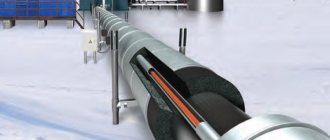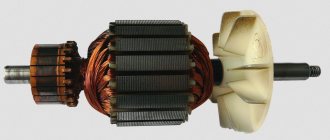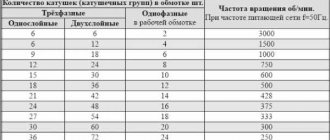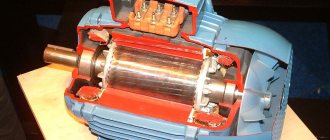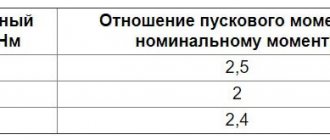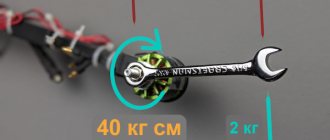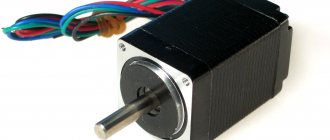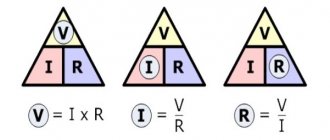Determining the number of pole pairs in an asynchronous electric motor is actively implemented, regardless of the environment in which the power units are used. This helps to determine the exact number of operations for which the motor is used and control its life. We will write about all the features further.
Shaded pole asynchronous motor
An asynchronous power unit is a device whose main purpose is to convert electrical energy into mechanical energy, which drives the working components of the equipment. At the same time, the rotation frequency of the stator magnetic field is by default higher than that of the rotor. The intensity of rotation of the shaft of such a power unit is directly determined by the number of poles of the copper winding. This indicator is one of the most important, determining the functioning of the motor. Later in the article we will talk about determining the exact number of points for motors with asynchronous rotation of the rotor and stator.
General statements
In fact, the number of poles is always an even number (because of this, it is pairs of points that are counted, and not individual elements). In modern asynchronous electric motors, two types of winding are implemented:
Read also: Why do you need self-education?
- concentrated;
- distributed.
Concentrated winding is suitable for brushless motors. You can easily change the number of antipodes by changing the connection of the coils. The six-winding stator allows two key connection types. One has vengeance on two sides, the other on four or eight. However, changing the number of poles of a finished motor to four or eight is unwise. Distributed winding, which is often used to provide 12 points on a nine-slot stator, is suitable for induction motors. In this case, the quantity is selected even before starting to wind the motor.
Although small motors typically have four poles, two-pole motors are also used for high-speed applications requiring 50 or 60 revolutions per second. Before brushless motors were introduced, a technique was once used to change the number of poles in squirrel cage induction power units. The basis of the method involves changing the connection type of complex windings, which cannot be classified as a distributed coil or a concentrated winding. This method was an attempt to allow operation at two different speeds by changing the synchronous speed. Motor models with coils of this variety are called split-side motors.
Additionally
Electrical wear resistance (switching) - the number of operating cycles (on-off) under load for which the protective automatic equipment is designed. Based on this value, the service life of the device is estimated. The optimal choice is a circuit breaker, RCD or automatic machine that can withstand up to 10,000 operating cycles.
Mechanical wear resistance - the number of operating cycles without load. This parameter is always greater than the previous characteristic, but in practice it is not taken into account.
Connecting an asynchronous motor to a single-phase network
Let us turn to the design of a three-phase asynchronous motor. As we know, there are 3 working phases of the engine, and there are also 3 terminals for connecting them. And in a single-phase household network of 220 Volts there are only two wires - phase and zero. What should I connect to the third terminal of the motor? If we connect a branch from any of these two wires to it, then we will simply get a short circuit with all the ensuing consequences.
The solution is to connect such a branch through a capacitor. The word “capacitor” is translated into Russian as “storage”. As you know, it works on the “charge-discharge” principle. That is, a capacitor connected to the network accumulates charge for some time, and then, when discharged, releases it back into the network. The time during which the capacitor accumulates charge is quite enough for the phase from which it is powered to “move” forward, to move in time. By moving, the phase seems to “free up space” for the discharge that the capacitor will produce, and eliminates the possibility of a “short” circuit. Due to the fact that the capacitor “shifts” the phases by its operation, it is called phase-shifting. You can read more about the operation of a capacitor in an alternating current circuit in this article. This creates the third wire necessary to connect the motor.
Connection diagrams for a single-phase network
Everything is quite simple here. We have to connect a capacitor between two phases. In a star scheme it will look like this.
How does a circuit breaker work?
A bonus is the device of the protective circuit breaker, several photos of the circuit breaker, which is given at the beginning of the article.
Circuit breaker device. As you can see, the device is not simple. Upper (fixed) contact – right
Circuit breaker. One second before the trash can)
Asynchronous electric motors
In previous sections, we discussed why AC motors are also called induction motors, or squirrel wheel motors. Next, we will explain why they are also called asynchronous electric motors. In this case, the relationship between the number of poles and the number of revolutions made by the rotor of the electric motor is taken into account.
The rotation frequency of the magnetic field is generally considered to be the synchronous rotation frequency (Ns). The synchronous speed can be calculated as follows: line frequency (F) multiplied by 120 and divided by the number of poles (P).
If, for example, the mains frequency is 50 Hz, then the synchronous speed for a 2-pole electric motor is 3000 rpm.
The synchronous speed decreases as the number of poles increases. The table below shows the synchronous speed for different numbers of poles. Synchronous speed for different number of poles
| Number of poles | Synchronous speed 50 Hz | Synchronous speed 60 Hz |
| 2 | 3000 | 3600 |
| 4 | 1500 | 1800 |
| 6 | 1000 | 1200 |
| 8 | 750 | 900 |
| 12 | 500 | 600 |
Dependence of frequency on the number of pole pairs
When considering the issue of obtaining alternating current, it is indicated that for one revolution of the rotor, the electromotive force (EMF) induced in the conductors of the generator winding had one period. If the generator rotor makes, for example, 5 rpm, then the EMF will have 5 rpm or the generator current frequency will be equal to 5 Hz. Consequently, the number of revolutions per second of the generator rotor is numerically equal to the current frequency.
The current frequency f is expressed by the following relation:
where n is the number of rotor revolutions per minute.
To obtain a standard current frequency of 50 Hz from the generator, the rotor must make 3000 rpm, that is
However, our reasoning was valid only for a two-pole generator, that is, for a machine with one pair of poles p.
If the machine is four-pole, that is, the number of pairs of poles is equal to two: p = 2 (Figure 1), then one full period of current change will take place per half-turn of the rotor (1 - 5 positions of the conductor in the drawing). During the second half-turn of the rotor, the current will have one more period. Consequently, during one revolution of the rotor of a four-pole machine, the current in the conductor has two periods. In a six-pole machine (p = 3), the current in the conductor will have three periods per revolution of the rotor.
Figure 1. Variation of alternating current in the rotor conductor of a four-pole generator
Thus, for machines with p pairs of poles, the current frequency at rpm will be p times greater than for a two-pole machine, that is
Hence the formula for the dependence of rotation speed on frequency and number of pole pairs will have the following form:
Example 1. Determine the frequency of the alternating current received from a generator with eight poles (p = 4), the rotor speed of which is n = 750 rpm. Substituting the values of p and n into the formula for determining the frequency of the current, we obtain:
Example 2. Determine the rotation speed of the rotor of a twenty-pole generator (p = 10), if the frequency meter showed the current frequency f = 25 Hz. Substituting the values of p and f into the formula for determining the number of rotor revolutions n, we obtain:
Example 3. The rotor speed of an asynchronous motor is 250 rpm. Determine the number of pole pairs of an asynchronous motor if the frequency of the supply network is 50 Hz:
Therefore, the motor has 24 poles.
Source: Kuznetsov M.I., “Fundamentals of Electrical Engineering” - 9th edition, revised - Moscow: Higher School, 1964 - 560 p.
www.electromechanics.ru
Electric motor parameters: table
| Parameter name | Unit | Note |
| Type | ||
| Rated power | Kilowatt | |
| Rated current | Ampere | For three-phase electric motors depends on the type of winding connection |
| Rated voltage | Volt | |
| Power factor (efficiency) | ||
| Efficiency factor (cos ϕ) | % | |
| Rated rotation speed | Revolutions per minute |
But sometimes the sign is missing or impossible to read. During operation, the engine is painted several times, often along with the nameplate. Therefore, it is necessary to determine its parameters by measurement.
Rated breaking leakage current
This value shows the leakage current at which the RCD / automatic circuit breaker is triggered. The sensitivity of the device is judged by the rated breaking current. The unit of measurement is milliamps (mA).
Approximate values of rated breaking current:
- 10 mA – for a washing machine, dishwasher, boiler and other equipment belonging to the wet group;
- 30 mA – for socket and lighting groups;
- 100 mA – to protect wiring from fire in a small apartment;
- 300 mA – to protect wiring from fire in an office or private home.
Electric motors as part of gearmotors
Electric motors have long been included in various gearmotors. They find their application in three-stage MTs3U type. and in two-stage type MTs2U. Electric motors have almost 90% efficiency and do not require constant maintenance. An important parameter is the exceptional environmental friendliness of the electric motor; there are no harmful emissions at all, which makes it indispensable for indoor installation. In short, electric motors are currently recognized as 3 or even 4 times more efficient than traditional internal combustion engines.
But sometimes, in the event of an electric motor failure, the buyer finds out that absolutely no accompanying documentation is attached to it. Marking nameplates, even if they have been preserved, may be in a worn-out, shabby state, so that it is simply impossible to see anything on them. How, then, can you determine the engine power and its speed? Here are some step-by-step tips to help you do this.
It should be borne in mind that the number of revolutions refers to the so-called asynchronous speed. Synchronous speed is the speed of rotation of the magnetic field. Asynchronous speed is slightly lower than synchronous due to the presence of mass in the rotating element, as well as the influence of friction forces, which can significantly reduce the efficiency of the motor. However, in practice these differences are almost never of decisive importance.
There are currently 3 main categories of asynchronous electric motors on the market. The first category of the catalog is motors operating at 1000 rpm. In practice, this number is about 950-970 revolutions, but for clarity, it is still rounded to the nearest thousand. The second category is motors producing 1500 rpm. This is also rounded as the actual range is 1430-1470. The third is 3000 rpm. Although in reality such a motor produces 2900-2970 rotations.
How to find out the speed of an electric motor yourself
Often, when buying an electric motor secondhand, the car owner (and not only) subsequently discovers that there is no documentation for it. In this case, as a rule, you have to independently determine the speed of the electric motor, and many, as practice shows, do not know how to do this. This article will tell you how to determine the speed of an electric motor yourself and what you should know.
Step-by-step instructions for determining speed
1. Today, asynchronous electric motors are divided into three groups, each of which indicates an individual rotation of the rotor per minute. The first group is electric motors that make 1000 revolutions per minute. It is worth immediately noting that this figure is slightly exaggerated, since the motor is asynchronous.
As a rule, it makes about 950-970 revolutions, but for convenience, experts decided to round such numbers. The second group includes engines whose rotor revolutions number 1,500 per minute. This figure is also rounded; in fact, the electric motor makes 1430-1470 revolutions per minute.
The third group of asynchronous electric motors is the group that includes a part whose rotor rotates around itself three thousand times in one minute. The real speed figure is 2900-2970.
2. In order to determine the speed of the electric motor, you first need to identify which of the above groups it belongs to. To do this, open one of its covers and find the winding coil underneath. Remember, such a coil can consist of one part or several, in particular three or four. Among other things, know that there can be several such coils in an electric motor. You only need one, which requires the least amount of effort to look at.
3. Attention! The coils are connected to each other by certain details, which sometimes make it difficult to view the necessary information. Under no circumstances should anything be disconnected from each other. Take a close look at the part you have chosen and try to approximate the size of the coil relative to the stator ring.
4. To find out the speed of the electric motor, this distance does not need to be determined accurately. Approximate calculations will work for you.
If the size of the coil approximately covers half of the stator ring, then the rotor rotation speed is three thousand revolutions per minute.
If the size of the coil covers approximately a third of the ring itself, the electric motor will belong to the second group and, therefore, the number of revolutions it can make will not exceed 1500 per minute.
When the size of the coil is equal to one fourth in relation to the ring, the speed of the electric motor will be 1000 revolutions per minute and, accordingly, the engine will belong to the third group.
Do not forget that the indicated figures are just an approximate picture of rotation; in reality they may differ and this depends on many factors.
These articles will also be useful to you:
Now watch this helpful video:
Many have probably seen and already have such wonderful accessories made from kanzashi flowers in their wardrobe. This article will teach you the technique for making them. Flowers made from satin ribbons - kansasi.
In this lesson you will learn what modular origami is and for your study a diagram of the assembly of a double swan will be presented, which you can assemble with your own hands.
For owners of garden plots, greenhouses, garages and any premises that need insulation. Having loaded such a stove once with firewood, you can then not approach it at all for a couple of days.
Nowadays there are more and more lollipops, Twixes and other overseas products on sale. Why don’t you make a cockerel on a stick today and please your child with such a non-standard gift.
How to prepare a product for smoking in camping, home and country conditions, select smoking wood, make homemade smokehouses, smoke a product, and do it all with your own hands.
Electric motor parameters: winding connection type
This is a very important parameter of a three-phase electric motor. All six terminals of the beginnings and ends of the windings are brought out into the engine bar. They can be connected either in a star or in a triangle.
Next to triangle/star
The plate indicates the rated voltage
– “220/380 V”
. This means that when a three-phase current with a voltage of 380 V is connected to the network, the motor windings must be connected in a star. An error in the connection will result in motor failure.
The rated current is also indicated as a fraction. In the described case, the value specified in the denominator is required.
Release type
Thermal - a simple, cheap and reliable release. Not afraid of dirt and vibrations. The response time is determined by the value of the overload current. Cons: sensitivity to temperature changes, probability of false alarms when heating, constant power consumption. Such a machine is installed away from heat sources.
Electromagnetic - characterized by a simple design and resistance to mechanical influences, such as shock or vibration. Disadvantages: instantaneous operation, occurrence of a magnetic field.
Electronic – has several settings options and performs them accurately. The advantages include the presence of an indication of the reason for the device’s operation. Cons: high cost, sensitivity to mechanical loads and electromagnetic fields.
Magnetic-hydraulic – resistant to vibrations and ambient temperature. Found in power circuit breakers.
Components of an electric machine
The basis for an electric machine is the rule of electrical induction with magnetic induction. Such a device includes a stator or, as it is called, a constant part (typical for asynchronous, synchronous machines of variable current) or an inductor (for devices of constant current) and a rotor, it is called an active or moving part (for asynchronous and synchronous machines of variable current) or an armature (constant current devices). Magnets (of a constant state) are actively used as a constant part for current machines with low power.
Automatic modular switch: device
Modular machines are supplied in housings made of non-flammable plastic and designed for installation on a DIN rail. For this purpose, the products are equipped with special latches. This design greatly simplifies installation. The devices have standardized dimensions: the width of the switches is indicated in modular distances (modules) equal to 18 mm.
The main part of the devices are thermal or electromagnetic releases that respond to overcurrents. The former are made on the basis of bimetallic plates, the latter - on coils with movable cores. In addition, inside the case there is an arc-extinguishing chamber that protects the device from the effects of an electric arc, and contacts responsible for breaking the circuit.
Mechanical characteristics of the engine
The mechanical characteristic is the dependence of torque on slip at constant voltage and network frequency.
In Fig. Figure 19 shows the mechanical characteristics of the engine. When starting, the engine develops a starting torque MP
(S = 1); if the starting torque is greater than the resistance moment of the working machine MS
, then the engine rotor will turn and the engine will operate at point a of the characteristic.
Increasing the moment of resistance of the working machine MS
, we will increase the slip, and point a will begin to move along the characteristic to point At point 1, the engine develops maximum torque, slip corresponding to the maximum torque, which is called critical - SKR
.
MC
increases above the torque
Mm
, the slip quickly increases and the motor rotor stops (the motor “rolls over” occurs).
The ratio of the starting torque to the nominal is called the starting torque multiple:
Rice. 19. Mechanical characteristics of an asynchronous motor
The starting torque multiplicity is indicated in the reference data catalogs; it must be greater than 0.9.
The ratio of the maximum torque to the nominal torque is called the overload capacity of the motor:
The overload capacity is indicated in the catalogues. It is usually in the range of 1.7-2.5. The mechanical characteristic has two characteristic branches: branch ( A-B
) is the stable part of the characteristic (with increasing slip, the engine torque increases); branch ( B
-
C
) - unstable part of the characteristic (with increasing slip, the engine torque decreases). If an active resistance is introduced into the circuit of a motor with a wound rotor, then the maximum torque, without changing in value, moves to the region of higher slips (Fig. 20, mechanical characteristic II). You can select such a resistance in the rotor circuit that the maximum torque will occur at start-up.
Rice. 20. Mechanical characteristics of an asynchronous motor with a wound rotor
Curve I for normal motors shows that the asynchronous motor has a rigid speed characteristic. An asynchronous motor with a wound rotor with resistance in the rotor circuit has a softer characteristic (curve II). By increasing the resistance in the rotor circuit, you can shift the maximum torque and make it equal to the starting torque.
Speed control by changing the number of pole pairs - Help for engineer
Speed control by changing the number of pole pairs
Speed control by changing the number of pole pairs became possible due to the sectional design of the stator of a squirrel-cage induction motor. In practice, 2, 3, 4-speed asynchronous motors are produced, where the number of pole pairs is always a multiple of an integer, as a result of which this method provides only step speed control, and the motors are called multi-speed. In fact, there are a large number of stator winding circuits, but the most commonly used are:
— switching the triangle-double star winding; - switching the winding star-double star.
Triangle double star
Figure 1 – Triangle-double star switching diagram
Figure 2 - Mechanical characteristics when switching from triangle to double star
A - triangle; B is a double star.
This type of speed control, in particular cases, switches speed with some temporary energy recovery. This switching method has found a niche in lifting mechanisms. You can see that as the number of pole pairs increases, the speed drops by half, but the critical moment also doubles, which gives us the ability to lift, but at a slower speed. This operating condition is called “traction” mode.
Comparing the powers, it is clear that the power changes slightly, and the speed changes in a stepwise manner by half.
Considering in more detail the mechanical characteristic during such a switching, we can notice that working at point 1, curve A, when switched on to a double star circuit, the asynchronous motor will move to point 2, curve B, and regenerative braking will begin to occur until the motor will switch to motor mode, and then to operating point 3, curve B. This braking is possible when the rotor speed of the asynchronous motor is greater than the synchronous speed. We looked at a particular example of such work in a previous article about back-braking, which described how loads are lowered in lifting mechanisms with energy released into the network.
Star-double star
Figure 3 – Star-double star switching circuit
Figure 4 - Mechanical characteristics when switching from star to double star
A - star; B is a double star.
The figure above shows that the critical moment remains the same, but the synchronous speed is halved.
Speaking of power, when switching to a double star, it doubles. When switching the windings, working at point 1, curve A, we will move to point 2, curve B, and from point 2 to point 3, just as in the previous case, regenerative braking will be carried out.
Add a comment
h4e.ru
Determining the exact quantity
Above, we have already described how to adjust speed indicators using the number of pole pairs of the motor. How can you independently determine the exact number of these pairs?
The rotation speed of an asynchronous type motor in most situations is interpreted as the angular speed of its rotor. As a rule, the exact value of the indicator is indicated on a technical plate mounted on the side of the engine housing. The indicator is expressed in revolutions per 1 minute.
Three-phase power units support the possibility of power supply from networks with one operating phase, but to implement such an idea, you need to connect a capacitor. It’s not easy to do this, but simultaneously one or more of its windings, focusing on the voltage level of the power supply network. This will not fundamentally affect the design of the engine.
If during operation the rotor, under load, rotates 2760 times in 1 minute, then its angular frequency will be equal to 289 radians per second. It's quite easy to calculate:
2760 * 2pi/60rad.
The resulting indicator is more technical and inconvenient for the average user to understand. That is why the performance indicators of the motor are indicated simply and clearly - in revolutions per minute.
The level of coordinated speed of such a motor (without taking into account such an important value as sliding) is equal to 3000 rotations. This is due to the fact that the power supply to the starter windings of the network has a frequency of 50 Hz. Every working second, the magnetic flux will carry out 50 full changes. Based on this - 50 * 60 = 3 thousand. The effective indicator is the synchronous speed of an asynchronous type electric motor.
Next, we will look at another method for determining the speed level of a conventional three-phase unit by conducting a visual inspection of the stator. By assessing the appearance of the stationary part, the location of the copper windings and the exact number of slots, it is possible to easily accurately determine the number of motor revolutions. This feature is especially useful if you do not have a measuring device such as a tachometer.
Adjusting the motor speed
Many people ask the question: Why is it necessary to have information about the number of pairs of poles? The first thing that is easy to do using these data is the regulation of rotation speed in an asynchronous motor.
Modern manufacturing industries use a fairly wide range of industrial equipment that perform specific tasks. At the same time, there is no need to ensure smooth adjustment of the speed of revolutions; it is enough to have a limited list of speeds (only the most important, most often used). This type of units includes machine tools in the metalworking and woodworking industries, winches in production wells, centrifugal separators, etc.
A limited number of operating speeds is easily provided by multi-speed motors of squirrel-cage design (with shielded poles). There can be two modifications of such equipment at once:
- with one stator winding, which supports the switching function, to implement different pairs of poles at once;
- with several windings of a stationary component, which are located in the same slots.
The interaction of the rotor MDS with the stator element is realized only in situations of complete equality in the numbers of winding pairs of these two components. That is why, when changing the number of pole pairs on the stator, it is necessary to change them in the rotor.
If there is an asynchronous unit with a phase-type armature, then in order to fulfill this condition, it is necessary to have auxiliary contact rings available. This feature helps to increase the external dimensions of the structure and, consequently, the cost.
A short-circuited control armature with a squirrel-cage winding has the ability to automatically generate a set of pairs that will be equal to the same list, but with a stator driving force. This quality determines the use of short closed armatures in asynchronous motors operating at many speeds.
Multi-speed power units with a large number of coils on the stator are inferior to models with a single winding. This is expressed in budgetary and technological terms. Devices with many coils make poor use of the stator winding and demonstrate irrational use of slots. The efficiency and cos ϕ are an order of magnitude lower than the optimal values.
This important feature is why multi-speed single-winding electric motors are increasingly being used in the manufacturing industry. This is beneficial, because the units support switching to different volumes of pairs at once.
Essentially, by switching the direction of movement of currents in the sphere of windings, the method of working with magnetomotive forces in the middle of the stator bore is simultaneously changed. The result will be a changed speed of rotation of the MDS and, based on this, the flow itself. Most often, switching is used in a proportion of 1 to 2. It follows that the windings of each phase are created in the form of two spheres. Changing the direction of movement of currents in one of them makes it possible to obtain the required change in polarity volume by half.
To be more informative, let's give an example of such actions on an engine that switches to 8 points and 4.
Asynchronous motor winding
For a simpler understanding, we took an image of the winding of just one phase, the design of which includes two sections.
If we implement alternate connection of sections - when connecting the end of the first (1K) with the start of the other (2H), then as a result we will have 4 pairs of points or simply 8 poles. When the direction of current movement in another area is replaced with the opposite one, then the number of poles generated by the winding will be halved. Any current variations in the 2H environment can be carried out by breaking the jumper between sections 1K and 2K. The number of generated poles will be 2 times less, which is informatively demonstrated in image B.
This change in the number of poles is obtained as a result of changing the direction of the electric current in section No. 2, through the use of a coordinated start from the first. This is indicated in image B. Here, as in the previously described situation, the winding creates 4 poles, which fully corresponds to twice the speed of the electric unit.
When we compare two windings in multi-speed machines, we should preferentially use those circuits that provide the required nature of the dependencies of the indicators during operation. The latter include the moment permissible for heating from speed. Among other things, the circuits must have the smallest number of pins and contact elements.
Grouping connections
Again, for better convenience, let's introduce a criterion with the help of which it will be possible to easily and simply assign winding connections to a specific group. The torque that an electric motor with a squirrel-cage armature develops is calculated using the following formula:
Torque formula
Legend:
- p – the exact number of pole pairs in the stator winding;
- N2 – the exact number of armature coil rods when implementing the “squirrel cage” type;
- I2 – rotor rod current level;
- Ψ2 – angle of shift of vector type current, relative to the electromotive force of the rotor;
- Ф – flux of magnetic action of one pole pair.
Based on the heating conditions of the rotor (if ventilation conditions are neglected), the current (I2), working with several pairs of poles, must always be at the same level. The cosine of the angle Ψ2 from idle speed to the nominal torque should be as close as possible to indicator 1.
If all these conditions are carefully observed, the moment of the machine is expressed by the following equality:
M = s 1 *Fr.
(1)
Indicator C1, in turn, is expressed by another understandable formula:
Formula C1
To be fair, we will indicate the formula for calculating the electromagnetic moment, which is measured in joules. (2)
Electromagnetic torque in joules
By equating the two equations (1) and (2), we obtain a value of P that will be equal to 314 S1F.
The power indicator of the electromagnetism of the power unit for any volume of stator winding poles is calculated using the ratio of the element voltage in phases to the number of turns that are in the phase winding and connected in series.
Using this feature, it is possible to analyze with a high degree of accuracy all previously described methods for switching the number of pairs at the poles. Let's look at the images, which show all the key cases of switching from a large number of pole pairs to smaller ones. In our example situation this is 8 poles by four.
Switching diagrams for stator winding sections 8 and 4
As you can see in the diagram from Figure A, all two sections are streamlined currents moving in the same direction. All of them fully correspond to the high number of pole pairs. In the right diagram (in Figure B) we have counter-direction of currents, due to which we can judge about fewer pairs of pole pairs.
In all these cases, the number of turns connected in series on the 1st phase windings remains at a stable level. They are additionally supplied with phase voltage, also at a consistently identical level.
Based on all of the above, the ratio of power indicators in both cases is equal to 1, which indicates operation with a stable power value (schematically - P = constant). In this situation, in order to keep the power at a constant level, when the speed changes to double the speed, it is necessary to change the torque indicator in the opposite direction of its speed.
Schematic representation of switching poles of stator coils in a 1:2 ratio
Schematic diagram of switching the poles of the stator winding in a ratio of 1 to 2
As can be seen in the graphs, connecting parallel winding sections allows you to change the direction of current supply in each of the implemented spheres. This value is responsible for reducing the number of pairs. At the same time, the winding immediately creates 2 stars of a symmetrical arrangement, which are switched on to linear voltage. Applying this criterion, you can notice that when the transition to an increased speed is made, the power value doubles:
Power value doubles
These indicators fully comply with the statement M = constant.
Conditional comparison of circuits
If a comparative analysis of all the above-described schemes is carried out in relation to the required number of outputs and contact elements for the control apparatus, several features can be noticed:
- when connecting using a circuit diagram, you must have at least 9 pins and 12 contacts;
- The switching circuit when connecting sections makes it possible to reduce the number of outputs to six, and contact parts to eight.
Schematic diagram of winding pole switching
The presented diagrams indicate that at 2 winding connection speeds “stars” of parallel or series type were used. If there is a need to make changes to the voltage supplied to the single-phase winding, the coils should be paired using an ordinary or double delta circuit. In some situations, you can even combine the star-triangle methods. When choosing the latter option, all 3 sections of windings create a triangle, and the remaining 3 are connected to the vertices of the figure, creating “rays” of the “star” type.
Such connections are actively used in drives of various types of equipment, for example, in durable cutting machines. Also, models are often used in situations where there is a need to alternately connect a triangular circuit to 2 stars, using a parallel arrangement.
When the machine is running at low speed, 2 sections of each individual phase connected in series form the lines of a triangle, at the corners of which an uninterrupted power supply is provided. In this case, all spheres of the phase winding are surrounded by current with the same indicators, which is completely compatible with a large number of pairs.
In order to obtain high speed values, the top of the triangle, which was obtained by winding the phases, must be short-circuited, and the power supply cables must be moved to the average connection points of the winding sections for each individual phase. Based on this, there will be 2 stars connected in parallel.
Before you start making windings with your own hands, it’s worth knowing that the process of creating multi-speed single-winding solutions is an order of magnitude more complicated than double-winding ones. How many poles need to be implemented in the motor determines the speed and intensity of rotation of the power unit shaft and, as a result, its overall productivity.
Methods for determining the characteristics of an electric motor
To determine which of these groups the engine belongs to, you do not need to disassemble it, as some experts advise, in order to secure a work order. The fact is that disassembly of an electric motor can only be carried out by a sufficiently qualified master. In fact, it is enough to open the protective cover (another name is the bearing shield) and find the winding coil. There may be several such coils, but one is enough. If a coupling half or pulley is attached to the shaft, you will also need to remove the lower shield.
If the coils are connected using parts that interfere with viewing the information, these parts must not be disconnected under any circumstances. You need to try to determine by eye the ratio of the size of the coil and the stator.
The stator is the stationary part of the electric motor, while the moving part is called the rotor. Depending on the design features, either the coil itself or magnets can act as a rotor.
If the coil covers half of the stator ring, such an engine belongs to the third group, that is, it is capable of delivering up to 3000 revolutions. If the size of the coil is a third of the size of the ring, this is a motor of the second type; accordingly, it is capable of developing 1500 rpm. Finally, if the coil only covers a quarter of the ring, it is type 1. The electric motor develops a power of 1000 rpm.
There is another way to determine the rotation speed of the rotor shaft. To do this, you also need to remove the cover and find the upper part of the winding. The location of the winding sections determines the speed. Typically the outer section occupies 12 slots. If you count the total number of slots and divide by 12, you can get the number of poles. If the number of poles is 2, the motor has a rotation speed of about 3000 rpm. If there are 4 poles, this corresponds to 1500 rpm. If 6, then 1000 rpm. If 8, then 700 rpm.
The third way to determine the number of revolutions is to carefully examine the tag on the engine itself. The number on the marking at the end corresponds to the number of poles. For example, for marking AIR160S6, the last digit 6 indicates how many poles the coil uses.
The easiest way to measure the speed is with a special tachometer. But due to the narrow specialization of application, this method cannot be considered as generally available. Thus, even if no technical documentation has been preserved, there are at least 4 ways to determine the speed of an electric motor.
How to determine the rotation speed of an electric motor?
It is obvious that the correct operation of any electric machine requires compliance of such an important technical parameter as the rotation speed with the operating conditions.
All the main parameters of an asynchronous electric motor are indicated by the manufacturer on a metal tag - nameplate attached to its body. And of course, the given technical data necessarily contains information about the rotation speed at rated load.
However, in practice, there are quite often cases when it is necessary to determine the speed of an engine with a missing nameplate or with unreadable - erased inscriptions on it.
Of course, in such cases, an experienced electric drive technician will certainly be able to determine the rotation speed, but novice electricians involved in servicing electrical equipment may have some difficulties in resolving this issue.
The easiest way to determine the rotation speed of the shaft of a working “asynchronous machine” is with a tachometer. But, given that due to the narrow specificity of use, the presence of this measuring device is very rare, this method is not considered here.
We hope the method suggested below will be useful. It is applicable for small and medium power asynchronous electric motors with single-layer stator windings.
So, in our case, determining the rotation speed of an electric motor involves inspecting its stator winding. Therefore, you will need to remove the cover (bearing shield) from the engine. If a pulley or coupling half is attached to its shaft to transmit motion, we recommend removing the rear shield.
Having removed the cover and the fan impeller from the shaft, unscrew the screws, remove the rear bearing shield, and then inspect the end part of the stator winding. Next, you need to count the number of slots occupied by sections of one coil.
The total number of core slots divided by the number of slots occupied by sections of one coil (quotient) will be the number of poles. Knowing its value, we determine the rotation speed of the asynchronous electric motor:
2 – 3000 rpm; 4 – 1500 rpm; 6 – 1000 rpm.
Here it is worth considering one feature of asynchronous motors - the discrepancy between the speed of rotation of the magnetic field and the rotation of the rotor, so the speed can be 940 rpm instead of 1000 or 2940 rpm instead of 3000.
As you can see, this method of determining the rotation speed from the winding is not particularly complicated, however, it can be simplified; You will need to visually determine which part of the circumference of the stator core is occupied by sections of one coil:
The ½ part of the engine stator core occupied by sections of one coil indicates its rotation speed is 3000 rpm, ⅓ – 1500 rpm, ¼ – 1000 rpm.
>How to determine the power and speed of an electric motor without disassembling it.
How to find out the characteristics of an electric motor without markings.
Calculation of the number of revolutions of an asynchronous motor
A common motor in machine tools and lifting devices is a squirrel-cage motor, so the calculation example should be taken for this type. The mains voltage is supplied to the stator winding. The windings are offset from each other by 120 degrees. The resulting electromagnetic induction field excites an electric current in the winding. The rotor begins to operate under the influence of EMC. The main characteristic of engine operation is the number of revolutions per minute. We calculate this value:
n = 60 f/p, rpm;
where f is the network frequency, hertz, p is the number of stator poles (in pairs).
There is a plate with technical data on the motor housing. If it is not there, then you can calculate the number of revolutions of the equipment shaft yourself using other available data. The calculation is made in three ways.
- The calculation of the number of coils, which is compared with the standards for different voltages, follows the table:
- Calculation of operating speed by pitch of winding diameter using the formula:
2 p = Z 1 / y, where 2p is the number of poles, Z 1 is the number of slots in the stator, y is the winding pitch.
Select the appropriate engine speed from the table:
- We calculate the number of poles based on the core parameters using the formula:
2p = 0.35 Z 1 b / h or 2 p = 0.5 D i / h,
where 2p is the number of poles, Z 1 is the number of grooves, b is the tooth size, cm, h is the height of the back, cm, D i is the diameter of the teeth, cm.
Based on the results of calculation and induction, the number of turns of the winding follows and is compared with the values of the motor according to the passport.
Poles
The stator of an electric motor has several pairs of coils (p), which are connected to the mains voltage with a certain frequency (f). A magnetized field is created in the stator, which rotates synchronously during operation. Its operating speed fully corresponds to the power supply frequency and is calculated using the formula ns = 60f/p.
This magnetic field causes voltage in the rotor cage (which is compressed sheets on which a copper or aluminum winding is applied). The generated current and flux of the magnets cause the armature to rotate. If the rotor rotates at synchronous speed, it will not rotate in relation to the field occurring in the stator. No voltage will be induced in the armature, and the force rotating the rotor will decrease.
Therefore, the shaft of asynchronous motors always rotates at an asynchronous speed relative to the efficiency of the stator motor. The differences between these speed data are called slip, which usually ranges from 3 to 5%.
The difference compared to synchronous speed directly depends on the type of motor design and its efficiency. Next we will consider all these points in more detail.
Asynchronous motor with shaded poles diagram
Rotation speed measurement
Measuring the speed of rotation of shafts, gears, wheels and other elements is usually carried out using electronic tachometers. A typical diagram of an electronic tachometer is shown in Fig. 26.
Tachometers measure rotation speed n with dimension . Already the first glance at this dimension makes it clear that the tachometer must perform two types of measurements simultaneously. First, measure the number of revolutions (shaft, gear, wheel, etc.). Secondly, measure time. To perform such measurements, the electronic tachometer (Fig. 26) contains an electronic stopwatch, a photoelectric sensor and a LU logic device.
We got acquainted with the structure and operation of an electronic stopwatch in the previous section. Now let's get acquainted with the device and operation of the photoelectric sensor. It consists of a LED - an LED emitter, a photodiode - an FD receiver and an electrical pulse shaper FS1. The LED emits light onto the photosensitive surface of the photodiode of the PD receiver. In this case, the resistance of the photodiode drops. If an opaque material is placed on the light line between the LED and the PD photodiode, the resistance of the PD photodiode will increase sharply.
Rice. 26. Functional diagram of an electronic tachometer
This property of a photoelectric sensor is widely used in engineering and measurement. To measure the rotation speed, a disk 1 with holes rotating on shaft 2 is placed between the optocoupler (LED emitter and photodiode receiver) (Fig. 26). As the shaft rotates, 2 holes in the disk will interrupt the light flow between the LED LED and the PD photodiode. In this case, the resistance of the PD photodiode will continuously change synchronously with the shaft rotation frequency. The FS1 pulse shaper responds to changes in the resistance of the photodiode, converting each of them into rectangular electrical pulses at its output, standard in voltage and duration (see Fig. 27, (a). The faster disk 2 rotates, the higher the pulse repetition rate at the output of the shaper FS1.
Now let's get acquainted with the operation of the logical device of the LU (Fig. 26). A logic device has two inputs and one output. The principle of its operation can be formulated as “2-I”. That is, if voltage is applied to both the first and second inputs of the logical device LU (the “2-I” condition is met), then there will also be voltage at its output. If there is no voltage at at least one of the inputs of the LU (condition two “AND” is not met), then there will be no voltage at its output. This principle of LU operation is well illustrated by the graphs presented in Fig. 27.
Rice. 27. Graphs of electrical pulses during operation of the electronic tachometer circuit, (A) – pulses at the output of the FS1 driver at point A; (B) – pulses of counting time periods (from the output of the dividing decade DD4); (B) – pulses at the output of the logical device (at the input to SchD1); (D) – pulses that reset the counting decades at the start of a new counting period
In the process of measuring the rotation speed of shaft 2 with a tachometer (Fig. 26), electrical pulses are generated at the output of the FS1 driver at point (A) with the repetition rate of the holes in disk 1. These pulses are supplied to the first input of the logical device LU. At the same time, pulses of counting time periods arrive at the second input of the LU at point (B) from the output of the dividing decade DD4.
Looking at Fig. 27. It is not difficult to see that the “2-I” condition can be periodically fulfilled only at the moment when a voltage of 5 volts is applied to the second input of the LU at point (B) for 1 second. At the same time, electrical pulses caused by the rotation of disk 2 arrive from the output of the FS1 driver to the first input of the LU at point (A). Thus, at the output of the logical device of the LU at point (B), rectangular electrical pulses are formed, which in appearance repeat the pulses coming from the FS1 driver. They arrive at the counting decades of the SChD, which is why this mode is called “counting”.
After the pulse counting period, during the next period of time lasting 1 second, the voltage at the second input of the LU becomes zero. At the output of the LU, the voltage also becomes zero, since the “2-I” principle is not fulfilled. Accounting is not possible. On the counting decades, the counting result is displayed for one second. This mode is called "indication".
After the “indication” mode, the automatic control device for resetting the UUS (Fig. 26) generates at its output at point (D) a short electrical pulse, which is supplied simultaneously to the zeroing inputs of all counting decades. The counting decades are reset to zero and a new counting mode begins. Thus, the “counting” and “indication” modes are repeated cyclically.
To determine the rotation speed of a shaft, gear, etc. from the readings of an electronic tachometer, use the formula:
(2.18)
where: N – counting result on the counting decade displays; k – number of holes in the sensor disk; t – counting time period.
For example, the number 2400 was displayed on the counting decade displays of the electronic tachometer. There are 80 holes in the sensor disk. The counting time period is 1 second. In this case:
rps
If 60 holes are made in the circumference of the disk, and the counting period is equal to 1 second, then, taking into account the fact that there are 60 seconds in 1 minute, the electronic tachometer will show the rotation speed in the dimension .
The absolute error Δn of measuring the speed of an electronic tachometer is calculated using the following formula:
, (2.19)
where: Δtmeas – absolute error in the duration of the time pulse (from the instability of the reference frequency generator); nх – measured rotation speed; tmeas – duration of the time pulse (in our example it is equal to 1 second).
The relative error in measuring the speed with an electronic tachometer is determined by the formula:
(2.20)
For example, it is necessary to determine the absolute and relative errors in measuring the number of revolutions with an electronic tachometer if it shows the value of the measured rotation speed nx = 1000 rpm, and the absolute error in the duration of the time pulse Δtmeas = 0.0001 s. Using formula (2.19), we determine the absolute error in measuring the speed with an electronic tachometer:
Housing protection degree
This indicator is indicated as an IPXX code, where the first digit indicates the degree of protection against dust, the second - the degree of moisture protection.
Degree of protection against dust and foreign objects:
- IP10 – protection against objects measuring 50 mm or more;
- IP20 – protection against objects measuring 12.5 mm or more (fingers);
- IP30 – protection against objects measuring 2.5 mm or more (cables, tools, wire);
- IP40 – protection against objects measuring 1 mm or more (very thin cables).
Degree of protection against moisture:
- IP21 – protection against vertical drops;
- IP32 – protection against vertical drops falling at an angle of up to 15°;
- IP54 – protection against splashes falling in any direction. This device is installed outdoors.
Tags
stator windings mains stator. in the stator is laid on the stator. the stator flux is one per stator. stator slots divide the stator poles increase on the stator four for example the stator has if the rotor is an auxiliary rotor. the name of the rotor. the quality of the rotor can the shaft of the rotor part. rotation of the rotor rotations of the rotor which indicator of the rotor. with direct current alternating current direct current Generated current and movement of currents movement of currents in movement of current variations of current in electric current in
division
